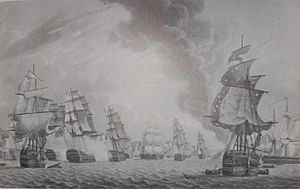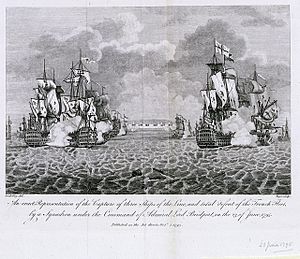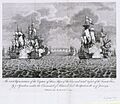Battle of Groix facts for kids
Quick facts for kids Battle of Groix |
|||||||
|---|---|---|---|---|---|---|---|
| Part of the naval operations during the War of the First Coalition | |||||||
 View of the Close of the Action Between the British and French Fleets, off Port L'Orient on 23 June 1795, Robert Dodd |
|||||||
|
|||||||
| Belligerents | |||||||
| Commanders and leaders | |||||||
| Strength | |||||||
| 14 ships of the line (OOB) | 12 ships of the line (OOB) | ||||||
| Casualties and losses | |||||||
| 144 killed and wounded | 670 killed and wounded 3 ships of the line captured |
||||||
The Battle of Groix was a big naval fight that happened near the island of Groix in France on June 23, 1795. It was part of the French Revolutionary Wars. The battle was between the British Channel Fleet and the French Atlantic Fleet.
The British fleet, led by Admiral Lord Bridport, was protecting a convoy. This convoy was carrying a French Royalist army to invade Quiberon. Meanwhile, the French fleet, led by Vice-admiral Villaret de Joyeuse, had sailed to rescue a French convoy.
The French fleet had already fought a British group on June 17, known as Cornwallis's Retreat. They were trying to get back to their base at Brest. But then, Lord Bridport's force of 14 ships of the line (large warships) appeared on June 22.
Villaret thought the British fleet was too strong for his 12 ships. He ordered his ships to retreat to the coast near Groix. He hoped to find safety in the protected waters there. However, some of his ships were too slow. They fell behind and were caught by the British ships. Three French ships were captured, and many sailors were hurt or killed.
Even though the British won, some people criticized Lord Bridport. They felt he stopped the battle too soon. Many historians agree that he missed a chance to completely destroy the French fleet. The invasion at Quiberon also failed later. The French fleet was stuck in Lorient port. They ran out of food, so many sailors had to leave their ships. This meant the French fleet could not threaten the British for the rest of the year.
Contents
Why the Battle Happened
French Fleet Struggles
The first two years of the French Revolutionary Wars were tough for the French Atlantic Fleet. This fleet was based at Brest. After the French Revolution, there was a lot of tension. The fleet had a mutiny in 1793. Many experienced commanders were removed or imprisoned.
In May 1794, the French fleet sailed to protect a grain convoy. They were attacked by the British Channel Fleet. This was the battle of the Glorious First of June. France lost seven ships, but the convoy was saved. In the winter of 1794–1795, five more French ships were lost. This happened during a bad storm known as the Croisière du Grand Hiver. By spring 1795, the British Channel Fleet was very strong. They kept the French fleet blocked in Brest.
Cornwallis's Retreat
In May 1795, the French commander Vice-amiral Villaret de Joyeuse sent a small group of ships. They were to escort a convoy of wine and brandy to Brest. On June 8, a British group led by Vice-Admiral William Cornwallis found them. The French ships hid near Belle Île. Cornwallis captured eight merchant ships.
Later, on June 16, Cornwallis found Villaret de Joyeuse with a much larger French fleet. This time, Cornwallis had to retreat. The French fleet chased him. One British ship, HMS Mars, was falling behind. Cornwallis used his large flagship, HMS Royal Sovereign, to protect Mars.
At the same time, Cornwallis made a clever move. He ordered a frigate to send fake signals. These signals suggested a large British fleet was coming. Villaret believed the trick. He called off the chase and returned to the French coast. This event became known as Cornwallis's Retreat.
Bridport's Mission
The British Channel Fleet was also at sea. It had sailed from Spithead on June 12. Admiral Lord Bridport commanded 14 ships. His job was to protect a convoy of transports. This convoy carried a French Royalist army. They planned to invade Quiberon in France.
The convoy reached Belle Île on June 19. Bridport sent the convoy to Quiberon. His main fleet stayed at sea to protect it. Bridport thought the French fleet was still in Brest. But Villaret's ships had been blown south by a storm. They were sheltering near Belle Île.
The Fight Near Groix
Villaret's Escape Attempt
A British frigate, HMS Arethusa, first spotted the French fleet. Villaret was leading his ships out of their sheltered spot. The British thought there were more French ships than there actually were. Villaret did not chase the British convoy. His ships were low on food.
On June 20, the British convoy saw Bridport's fleet. Bridport ordered some ships to join his fleet. He then sailed towards the coast. He wanted to get between the French fleet and the invasion convoy.
The wind made it hard for both fleets to move. Finally, on June 22, British scouting ships saw the French fleet. They were about 42 miles from the French coast. When Villaret saw the larger British fleet, he turned back towards land. Bridport followed, knowing the French admiral did not want to fight.
Bridport ordered his fastest ships to go ahead. These included HMS Sans Pareil and HMS Orion. Bridport followed in his large flagship, HMS Royal George.
All day, the chase continued. The British ships slowly gained on the French. Both sides were slowed by calm weather. Bridport spread his fleet out. This was to make sure they could catch the French. At 7:00 PM, Bridport signaled his ships to attack the French ships at the back.
A calm fell at 10:30 PM, stopping both fleets. At 3:00 AM on June 23, a light breeze started. This allowed Bridport's fleet to move again. At dawn, the French were straight ahead. The main French fleet was loosely grouped. Three or four ships were trailing behind. One ship, Alexandre, was far behind. It was only 3 miles from the British ships at the front. Alexandre was a slow ship. Its captain, François Charles Guillemet, also did not follow orders well.
The leading British ship was Queen Charlotte. It was moving very fast. Behind it were Irresistible, Orion, Colossus, Sans Pareil, and Russell. The rest of the fleet was further back. At 4:00 AM, the island of Groix was about 8 miles east of Queen Charlotte. Villaret was trying to reach this area. He hoped Bridport would not follow him into the narrow waters near the island. The coast there was dangerous, with reefs and rocks.
The Battle on June 23

Alexandre was in danger of being cut off. Villaret sent a frigate to tow it at 5:00 AM. Less than an hour later, Queen Charlotte got close enough to fire. Alexandre fired back, but Queen Charlotte and Orion soon joined in. The frigate towing Alexandre quickly left.
Villaret's fleet had split up again. Formidable was a little ahead of Alexandre. Villaret was in his 120-gun flagship, Peuple, ahead of Formidable. Other French ships were with Villaret. The rest of the fleet had gone far ahead. Villaret tried to get his ships into a battle line, but they did not follow his orders.
At 6:15 AM, Queen Charlotte passed Alexandre and started firing at Formidable. After 15 minutes, a fire broke out on Formidable. As the crew fought the fire, Sans Pareil fired at Formidable. This made Formidable slow down. Queen Charlotte had badly damaged Formidable. Its rigging was torn, and over 320 men were killed or wounded. Formidable surrendered.
While Sans Pareil and Queen Charlotte fought Formidable, other British ships pushed on. They went towards Villaret's ships. The French admiral kept trying to form a battle line, but failed.
At 7:00 AM, four British ships and six French ships fought in a confused way. The French ships at the front kept going east. The slower British ships struggled to catch up. The battle was getting closer to the island of Groix. Villaret wanted to shelter his fleet there.
Queen Charlotte had to pull out of the fight. Its rigging and sails were too damaged. At 7:14 AM, it drifted past Alexandre. Captain Guillemet of Alexandre fired briefly, then surrendered. Even as Queen Charlotte fell back, it kept firing at the French. Sans Pareil attacked Tigre, forcing it out of the French formation.
Villaret tried to gather his forces. He even put his frigate in front of his own fleeing ships. He hoped to stop them and make them fight. But it was no use. As Tigre fell out of line, Queen and London joined the attack. Tigre's captain, Jacques Bedout, was forced to surrender. Tigre was badly damaged, with water in its hold. Over 130 men were killed or wounded.
At 7:57 AM, Bridport's Royal George reached the battle. At 8:15 AM, Bridport ordered his leading ships to return to the fleet. He then pulled ahead. He caught the damaged Peuple near Groix. He fired at Peuple and Tigre. At 8:37 AM, Bridport turned away to the southwest. The rest of the British fleet followed. He ignored the remaining French ships.
After the Battle
Bridport ordered the captured ships—Alexandre, Formidable, and Tigre—to be towed. The British fleet was in good shape. Only Queen Charlotte had serious damage. The British lost 31 men killed and 113 wounded.
Bridport sent the captured ships back to Britain. He then turned his fleet back east. He wanted to support the invasion at Quiberon. The French Royalist forces landed on June 27. But the invasion failed a month later. Bridport stayed near Quiberon until September.
Villaret gathered his ships. He held a meeting with his officers. He thought Bridport would return to attack. He suggested anchoring near the coast in a strong defensive spot. But other officers disagreed. They said the British could easily attack them there.
So, Villaret decided to shelter the fleet in Lorient port. They needed supplies and repairs. But Lorient did not have enough food for such a large fleet. Villaret had to let most of his sailors go. It was not until December that some ships could quietly return to Brest. Others went south to Rochefort.
French casualties were high, with 670 killed and wounded on the captured ships. Villaret was very unhappy with some of his officers. He said they were ignorant or disobedient. Several French captains were put on trial. Two were dismissed from the Navy.
The British victory at Groix did not bring equal rewards. Bridport's report was short. Only his own captain was praised. The Parliament also thanked only Bridport and two other admirals. Many captains who fought bravely were not mentioned. Historians say that Queen Charlotte and its captain were especially unlucky.
All three captured French ships were taken into the British Royal Navy. Alexandre became HMS Alexander. Tigre kept its French name. Formidable became HMS Belleisle. Belleisle had a long and successful career. It even fought at the Battle of Trafalgar in 1805.
Many people debated Bridport's decision to stop fighting. He said the French ships were too close to shore and batteries. He also said his main duty was to protect the Quiberon invasion. But French Admiral Kerguelen believed the British could have captured or destroyed all the French ships. Historians agree that Bridport stopped too soon. They think a great chance to destroy the French fleet was missed.
Images for kids
-
View of the Close of the Action Between the British and French Fleets, off Port L'Orient on 23 June 1795, Robert Dodd
-
"An exact Representation of the Capture of three Ships of the Line, and total defeat of the French Fleet, by a Squadron under Command of Admiral Lord Bridport, on the 23 of June, 1795" E. Godefroy & J. Pass, 1795. NMM.





